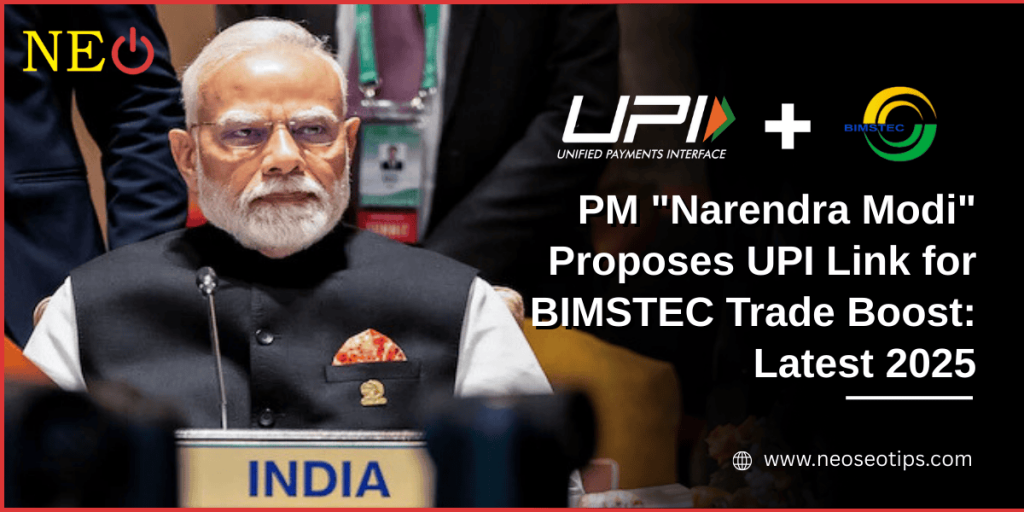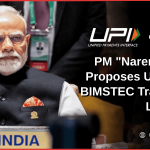Table of contents [Show]
Narendra Modi’s Bold Plan to Connect BIMSTEC with UPI:
On April 4, 2025, Prime Minister Narendra Modi shared an exciting idea at the BIMSTEC Summit in Bangkok. He wants to connect India’s Unified Payments Interface, or UPI, with the payment systems of BIMSTEC countries. These nations include Bangladesh, Bhutan, India, Myanmar, Nepal, Sri Lanka, and Thailand. This move could make trade, business, and tourism easier across the region. Let’s explore what this means and why it matters.
What Is UPI and Why Is It a Big Deal?
UPI is India’s fast and simple digital payment system. It lets people send money instantly using their phones. In India, over 300 million people use UPI, making billions of transactions each month. From buying groceries to paying bills, UPI has changed how Indians handle money. It’s part of the cashless economy push under Digital India. Now, it’s not just India. Countries like Singapore, UAE, and France have started using UPI too. Modi sees it as a tool to bring nations closer, and BIMSTEC is next on the list.
An Overview of BIMSTEC:
The Bay of Bengal Initiative for Multi-Sectoral Technical and Economic Cooperation is known as BIMSTEC. It’s a group of seven countries in South Asia and Southeast Asia. The goal is to work together on trade, energy, and more. These nations want to grow their economies and help each other. But trade between them is still small compared to their global business. Modi’s UPI plan could change that by making payments smoother and faster.
The Core of PM Modi's Suggestion:
During his speech, Modi laid out a clear vision. He suggested linking UPI with the payment systems of BIMSTEC countries. This would let people and businesses pay across borders without hassle. He also proposed a pilot study to figure out what each country needs. That way, the plan fits everyone. Modi didn’t stop there. He talked about creating a BIMSTEC Chamber of Commerce and holding yearly business summits. He even suggested trading in local currencies. These ideas aim to build a stronger regional economy.
How UPI Could Boost Trade and Tourism?
- Faster Payments for Businesses: A small business owner in Nepal could sell goods to Thailand and get paid instantly using UPI, avoiding slow bank transfers.
- Lower Costs: UPI eliminates high fees, making it easier for small businesses to profit and grow.
- More Trade Opportunities: Quick and affordable payments could encourage businesses to trade more with BIMSTEC neighbors.
- Convenience for Tourists: A traveler from Sri Lanka could pay for a meal in India with a simple scan, making travel smoother.
- Increased Tourism: Easy, seamless transactions could attract more visitors, boosting money spent in the region.
- Sparking Economic Growth: With trade-in BIMSTEC currently low, UPI could ignite a surge in business and economic activity.
Challenges That Could Slow Things Down:
Uneven Technology Levels-
- Not all BIMSTEC countries have advanced technology.
- India’s digital infrastructure is strong, but Myanmar and Nepal may lag.
Time and Cost of Setup-
- Setting up UPI in less advanced nations could take time.
- It might also cost a lot of money.
Cybersecurity Risks-
- More online payments increase the risk of hacking.
- Hackers could steal data or money.
Different Money Rules-
- Each country has its own rules about money.
- Leaders must agree on how to align these rules.
Potential Solution-
- These challenges are real and could slow progress.
- Modi’s pilot study might help find answers.
India’s Big Role in the Digital Future:
If this plan succeeds, India could lead the way in digital payments for South Asia and Southeast Asia. UPI is already a global success story. Sharing it with BIMSTEC shows India’s willingness to help its neighbors grow. It’s not just about money. It’s about building trust and teamwork. Modi’s ideas like trading in local currencies could make the region less dependent on outside systems. This could create a more resilient economy for everyone. The world is watching to see if BIMSTEC can pull this off.
Conclusion,
Narendra Modi’s proposal to link UPI with BIMSTEC payment systems is a game changer. It’s a chance to boost trade, support businesses, and welcome more tourists. The plan builds on UPI’s success in India and beyond. It fits BIMSTEC’s goal of working together for a stronger future. Yes, there are challenges like technology gaps and security risks. But with careful planning, this could work. India is stepping up as a leader in digital innovation. If all goes well, BIMSTEC could become a powerhouse of economic cooperation.









